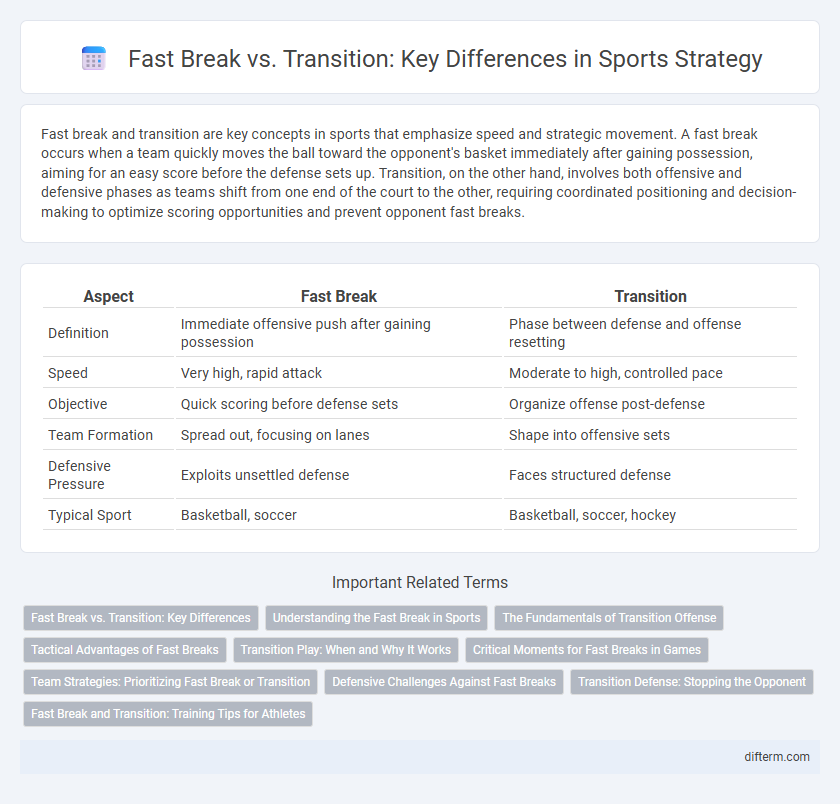Fast break and transition are key concepts in sports that emphasize speed and strategic movement. A fast break occurs when a team quickly moves the ball toward the opponent's basket immediately after gaining possession, aiming for an easy score before the defense sets up. Transition, on the other hand, involves both offensive and defensive phases as teams shift from one end of the court to the other, requiring coordinated positioning and decision-making to optimize scoring opportunities and prevent opponent fast breaks.
Table of Comparison
| Aspect | Fast Break | Transition |
|---|---|---|
| Definition | Immediate offensive push after gaining possession | Phase between defense and offense resetting |
| Speed | Very high, rapid attack | Moderate to high, controlled pace |
| Objective | Quick scoring before defense sets | Organize offense post-defense |
| Team Formation | Spread out, focusing on lanes | Shape into offensive sets |
| Defensive Pressure | Exploits unsettled defense | Faces structured defense |
| Typical Sport | Basketball, soccer | Basketball, soccer, hockey |
Fast Break vs. Transition: Key Differences
Fast break and transition both involve quick offensive moves after a change of possession, but a fast break is a rapid, organized attack designed to score before the defense sets up, often featuring fewer passes and higher speed. Transition refers to the entire process of shifting from defense to offense, emphasizing team structure and spacing to exploit defensive vulnerabilities. Understanding these distinctions is crucial for optimizing team strategy and improving scoring efficiency in basketball.
Understanding the Fast Break in Sports
The fast break in sports is a rapid offensive strategy designed to capitalize on an opponent's momentary disadvantage, often initiated immediately after a defensive rebound or turnover. This tactic emphasizes speed, quick decision-making, and precise passing to outrun defenders and create high-percentage scoring opportunities before the opposing team organizes its defense. Mastering the fast break requires players to maintain optimal positioning, communication, and stamina to execute efficient transitions from defense to offense.
The Fundamentals of Transition Offense
In basketball, the fundamentals of transition offense revolve around quickly advancing the ball after a defensive rebound or turnover, exploiting the opponent's unsettled defense. Fast breaks emphasize speed and quick decision-making to create high-percentage scoring opportunities before the defense can set up. Effective transition offense requires precise passing, court vision, and spacing to maintain momentum and capitalize on numerical advantages.
Tactical Advantages of Fast Breaks
Fast breaks exploit defensive disorganization by accelerating ball movement and player positioning, creating high-percentage scoring opportunities before opponents can set up. This tactic leverages player speed, court spacing, and quick decision-making to maximize scoring efficiency and apply immediate pressure. Teams utilizing fast breaks effectively disrupt defensive setups, increasing chances for uncontested shots and momentum shifts.
Transition Play: When and Why It Works
Transition play excels when a team quickly shifts from defense to offense, capitalizing on unsettled opponent defenses to create high-percentage scoring opportunities. It works best in situations where defenders are out of position, enabling fast ball movement and player spacing to exploit gaps before the opposing team can set up. Effective transition play relies on speed, court awareness, and precise passing to maximize scoring efficiency in the few critical seconds after a rebound or turnover.
Critical Moments for Fast Breaks in Games
Critical moments for fast breaks in basketball often occur immediately following defensive rebounds or turnovers, as the defense is not yet set. Exploiting these opportunities requires quick outlet passes and sprinting down the court to catch opponents off guard. Efficient fast breaks increase scoring chances before the opposing team can organize their transition defense.
Team Strategies: Prioritizing Fast Break or Transition
Teams prioritizing a fast break emphasize rapid ball movement and quick scoring opportunities immediately after gaining possession, exploiting defensive mismatches before the opposition sets up. Transition strategies focus on balanced offensive and defensive adjustments, ensuring organized positioning to maintain control and capitalize on scoring chances while preventing easy counterattacks. Coaches tailor team dynamics based on player speed, court spacing, and opponent tendencies to optimize either fast break aggression or a structured transition approach.
Defensive Challenges Against Fast Breaks
Defensive challenges against fast breaks include maintaining proper spacing and communication to prevent easy scoring opportunities. Defenders must quickly identify and match opposing players while recovering backcourt positions to disrupt the offensive tempo. Effective anticipation and positioning are critical to minimizing fast break efficiency and forcing no-look or contested shots.
Transition Defense: Stopping the Opponent
Transition defense is critical in basketball for stopping opponents from scoring easy fast-break points. Effective communication, quick defensive rotations, and assigning responsibilities to players allow teams to disrupt fast breaks and regain defensive positioning. Teams that excel in transition defense limit opponents' scoring opportunities, forcing half-court sets instead of uncontested transition baskets.
Fast Break and Transition: Training Tips for Athletes
Effective fast break training emphasizes explosive speed, precise passing, and quick decision-making to outpace opponents and capitalize on scoring opportunities. Transition drills should simulate game scenarios to enhance players' ability to switch rapidly from defense to offense, improving court awareness and positioning. Incorporating interval sprints, reactive exercises, and teamwork-focused plays maximizes athlete responsiveness during high-tempo game moments.
fast break vs transition Infographic

 difterm.com
difterm.com